The grapevine beetles are giant, scary-looking beasts that feast on grapevine leaves among these insect pests. The feeding of grapevine beetles makes holes in leaves and interferes with vines’ photosynthetic activity. Therefore, effective management practices are to be followed to manage this pest of vines effectively.
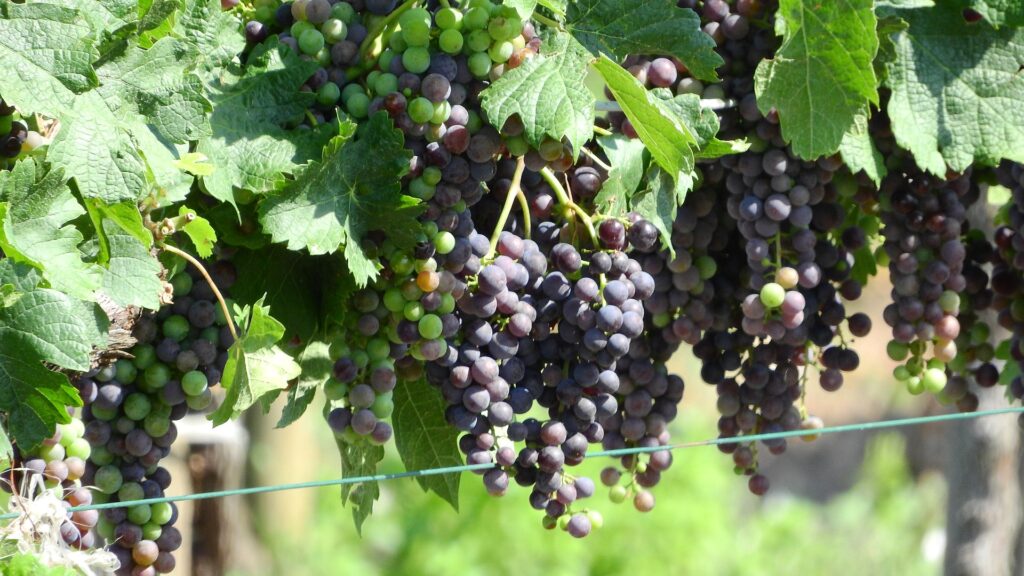
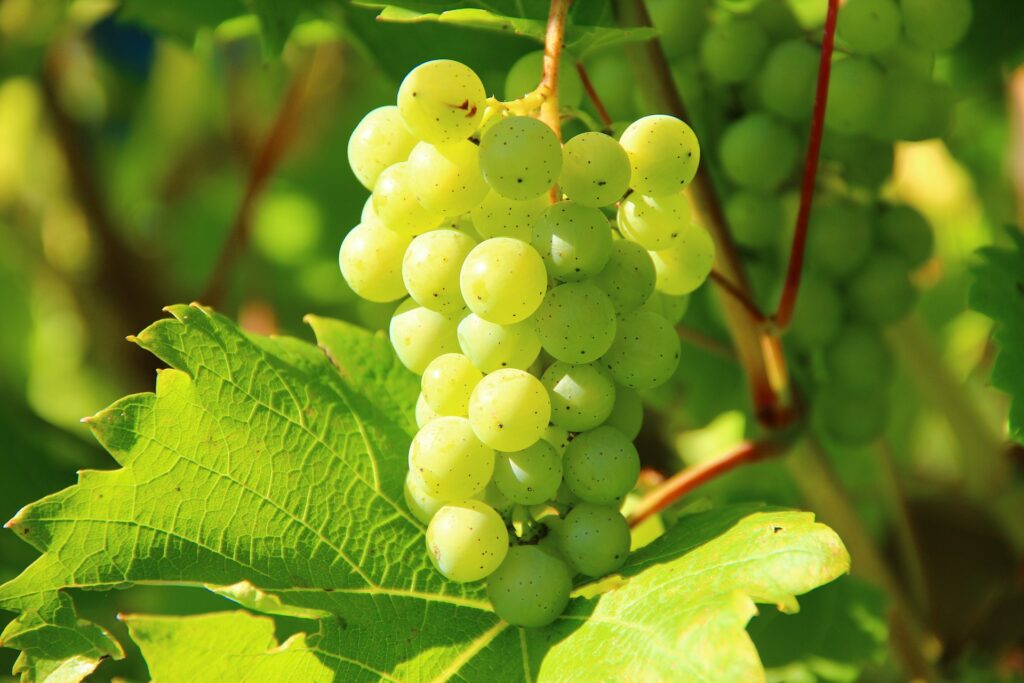
Grapevine Beetles
Grapevine beetle (Pelidnota punctata) is a member of the family Scarabaeide (scarab beetles) and is also known as spotted June beetle and Japanese beetles. The scarab beetle family is most commonly found in eastern Canada, the north and the central United States. Spotted June beetle or grapevine beetles cause little to no damage to their host plants. That’s why Pelidnota punctata is not considered a severe pest for its host plants.
These beetles fly at high speed and take curving flights. The members of the scarab family are attracted to light and are active at night, and their presence indoors irritates due to unpleasant noise.
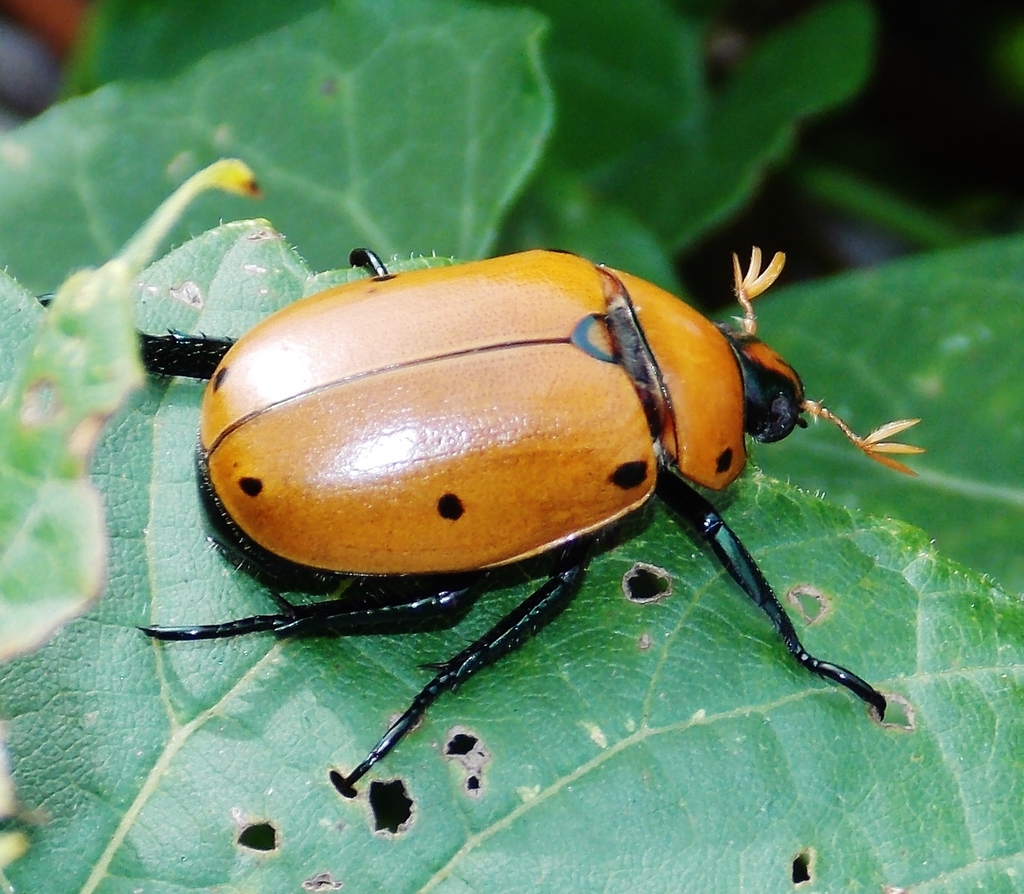
Habitats Of Grapevine Beetle
Grapevine beetles most commonly occur in Canada and the northern part of the United States. The genus pelidnota primarily resides in forests, gardens, vineyards, and rotten wood. However, these beetles prefer to stay outdoors and in places rich in decomposed plant matter.
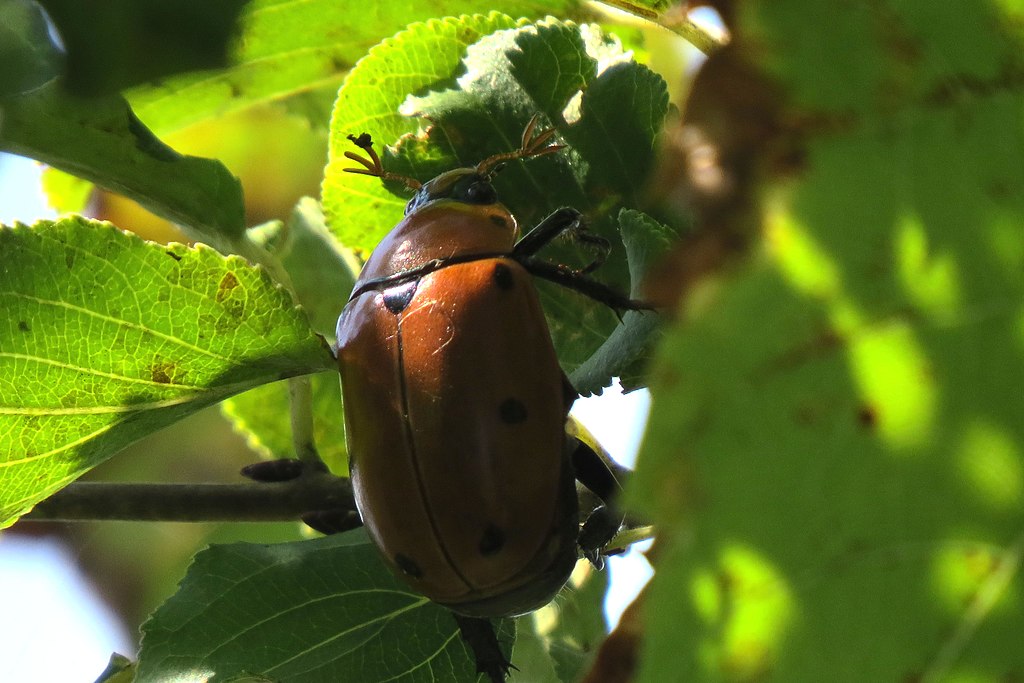
What Are The Host Plants Of Grapevine Beetles?
The host plant for adult beetles includes oaks, apple, walnut, maple, elm, and grapevines. The adults eat leaves and ripe fruits of grapevines. At the same time, the larvae feed on decomposed, dead leaves and rotting wood.
Identification Of Grapevine Beetles
The grapevine beetles are easy to find due to their sizable oval-shaped body. The adult spotted June beetle is 1 inch long. Their body color varies from yellowish orange to reddish red. The antennae of the grapevine beetle are unfurled into a fan and named lamellae.
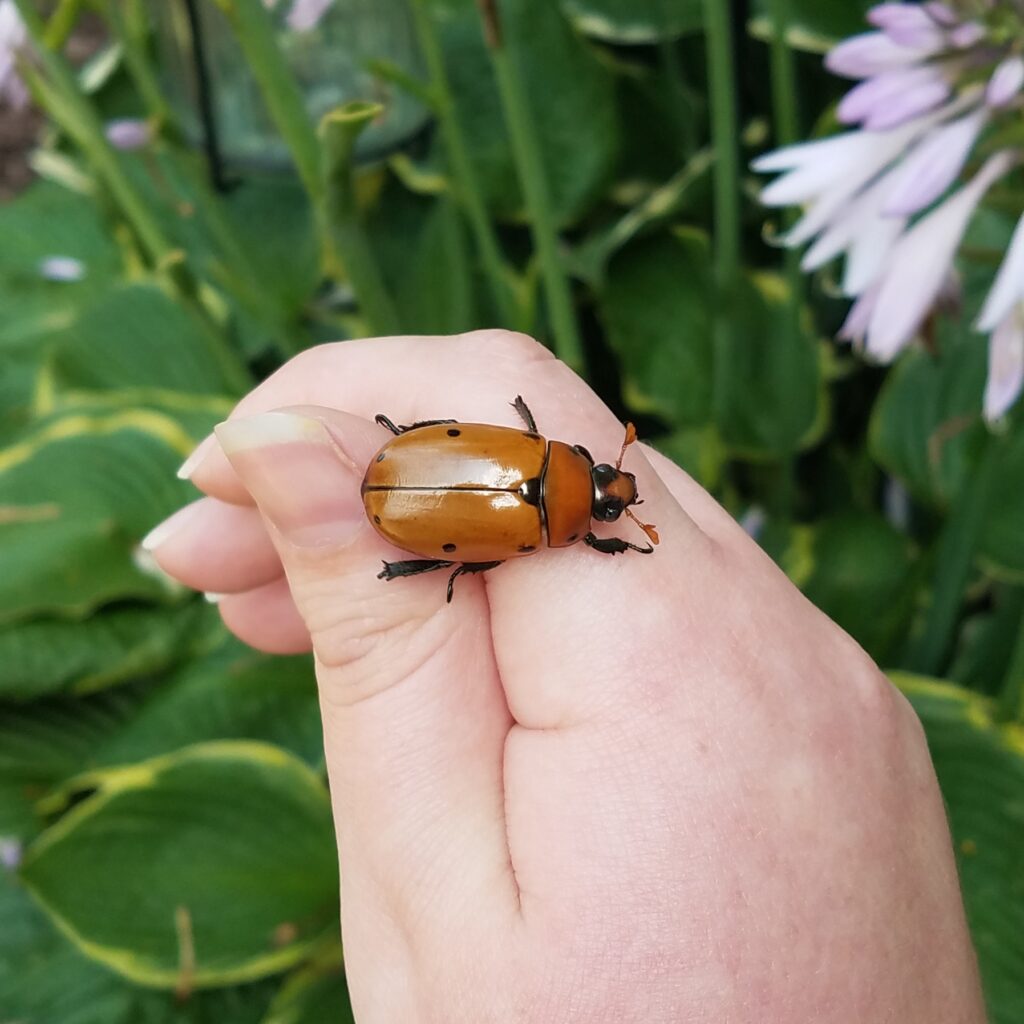
The body of the grapevine beetle comprises four black spots on each side, and a fine black line divides its elytra.
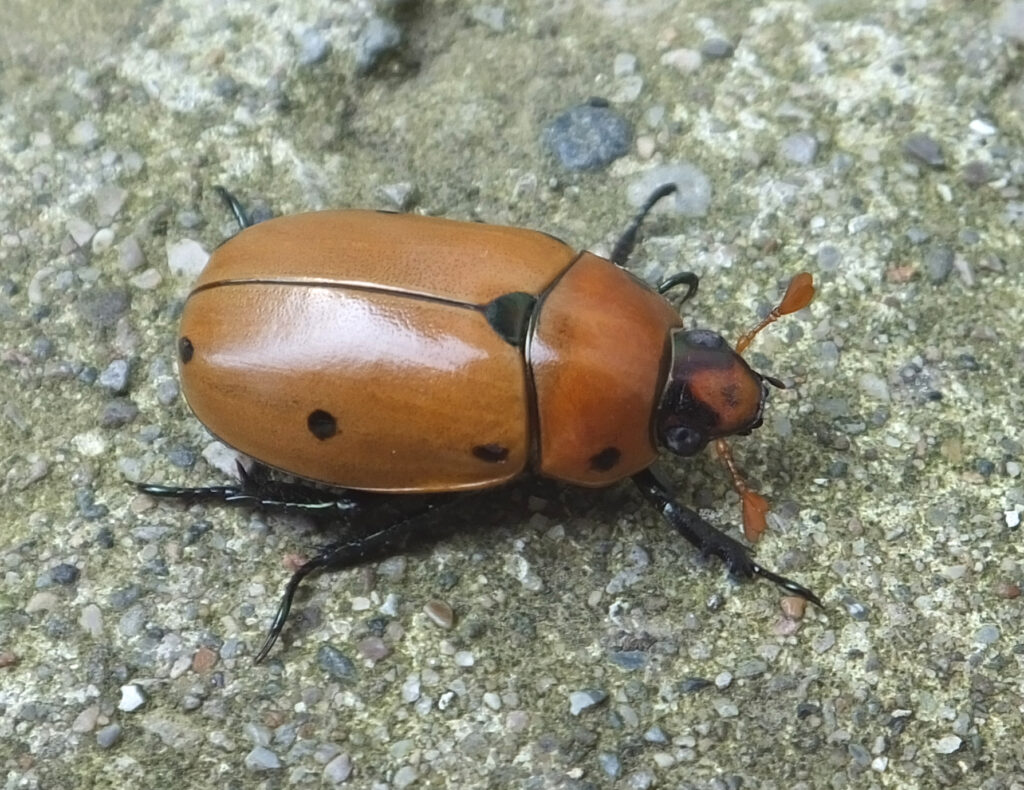
Another essential feature for the grapevine beetle identifications is variations in Pelidnota punctata body, such as the southern variations lack darker legs while the northern variations have darker legs.
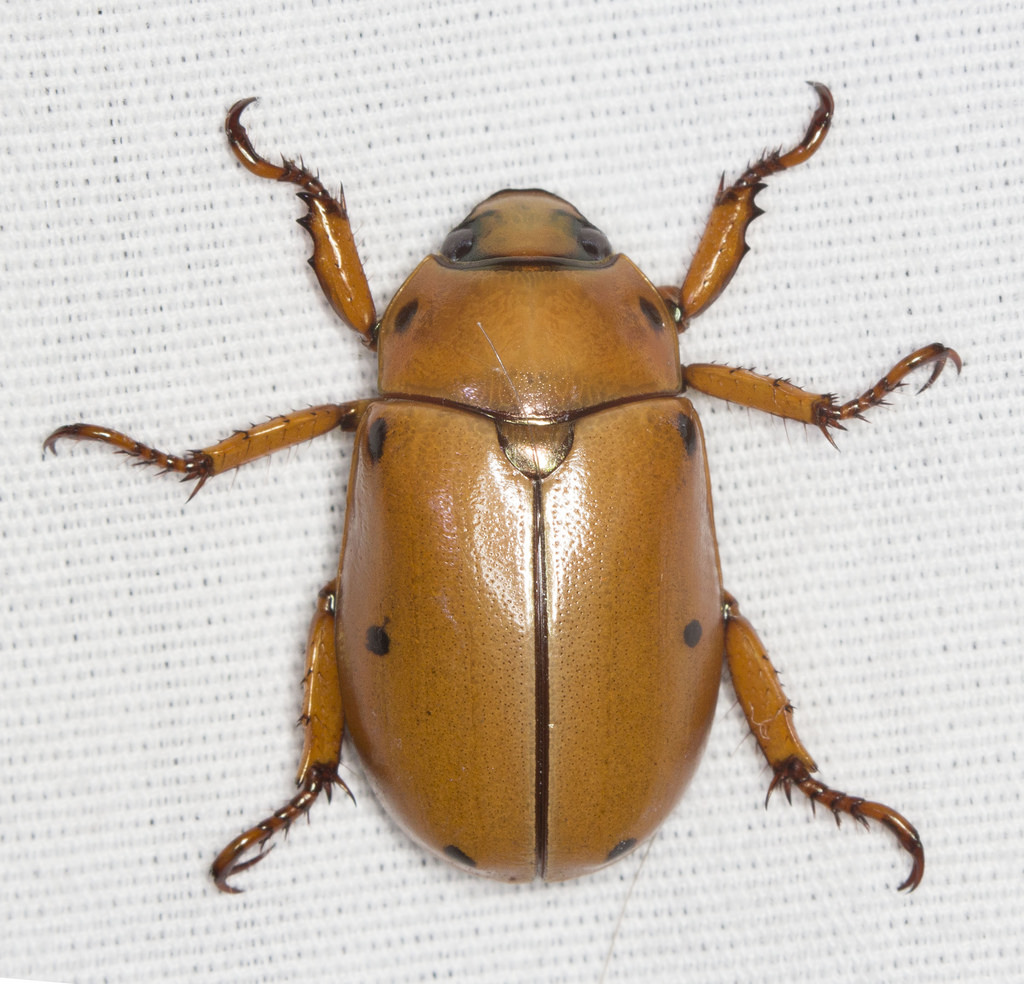
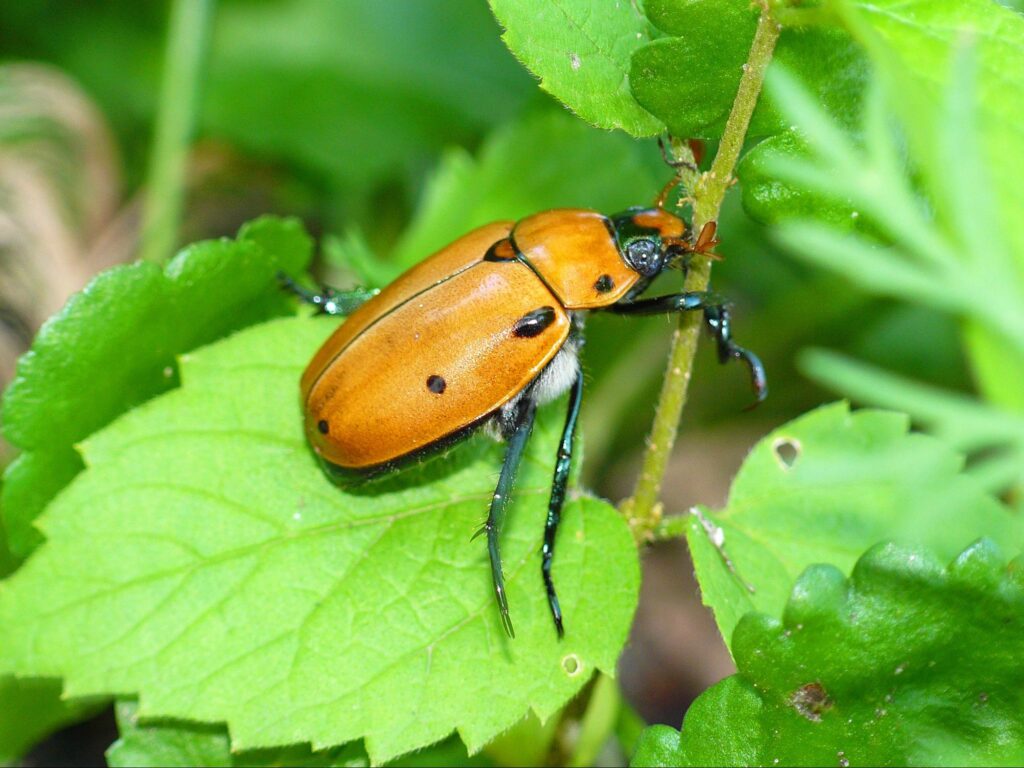
Life Cycle Of Grapevine Beetle (Pelidnota punctata)
The life cycle of the grapevine beetle consists of four stages. It has egg, larva, pupa, and adult stages. The adult females lay their eggs in the soil or rotting wood. Their eggs are laid in tree stumps and near host plants. After two weeks, the larvae hatch, feed on rotten wood roots and make their way up to the top.
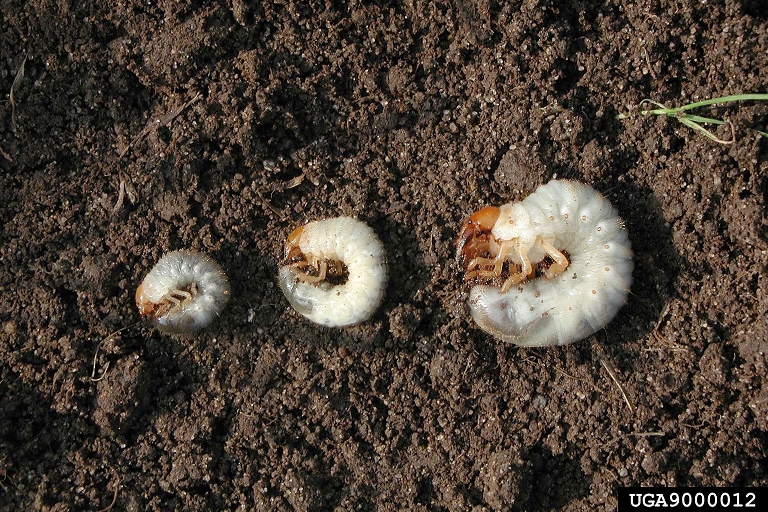
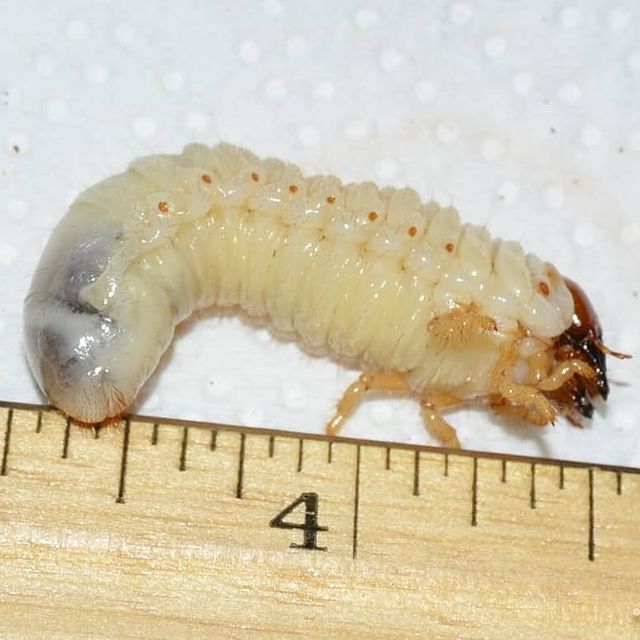
The larvae are two inches long and feed on grapevine leaves throughout the summer. The young larvae of Pelidnota punctata appear C-shaped with a white to pale color. As they grow older, the head of larvae turns into more dark brown.
Larvae then fall onto the ground and pupate. The pupae of the genus pelidnota appear dark brown and grow in the length of 2.2 cm. The pupal stages slowly build in the soil, and the adults emerge in July.

The adults take curving flights and eat leaves and fruits of wild and cultivated grapevines. The grapevine beetle completes its life cycle in a time of two years. First, they overwinter in the soil and again appear in Spring and feed on the leaves of apple, maple, and vines.
RELATED: Identification and Control of Darkling Beetles by Natural and Chemical Ways
Damage Caused By Grapevine Beetle
Pelidnota punctata is not considered a significant pest for their host plants. However, because they have minor damage or are relatively low, which does not require serious control measures, their presence is scary, unpleasant and alarming for other plant species.
The adults feed on the leaves and fruits of grapevines. Sometimes, they skeletonize the foliage and cause large holes in them, damaging photosynthesis and fruit quality. But most importantly, their damage is not always on a vast scale.
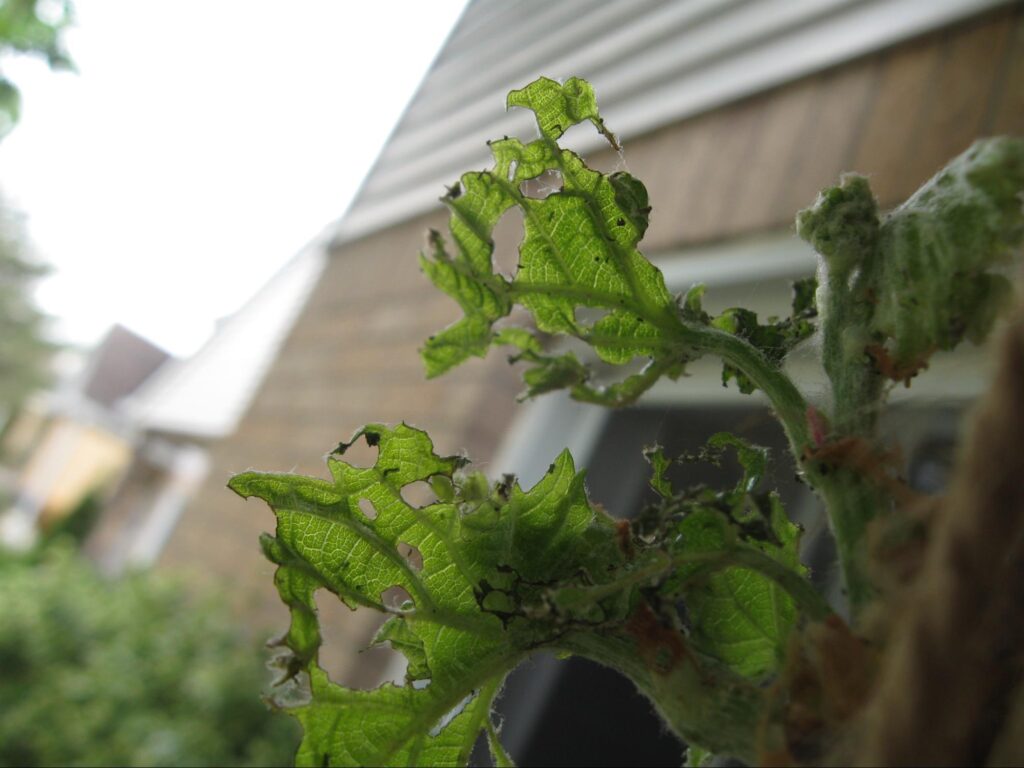
How To Get Rid Of Grapevine Beetles Effectively?
The management practices for grapevine beetle include insecticidal soap, insecticides (pyrethrins), organic control approaches, and cultural practices. The c shaped larvae and adults feed on the upper side of leaves and can easily be controlled by insecticidal spray.
Applications Of Chemicals Or Insecticides For The Control Of Japanese Beetles
The spotted pelidnota is not a pest of grave concern. However, chemicals can be used in late summer and early fall to manage grapevine spotted beetle presence. At this time, the insecticide applications will interfere with the life cycle of scarab beetles.
The insecticides with carbaryl or trichlorfon prove an effective remedy for controlling grapevine beetle adults and larvae. These are contact insecticides and kill the larvae before pupating in the soil.
The application of contact insecticides plays a vital role in managing grapevine beetles because they kill them at all stages of their life cycle and act as curative chemicals.

Always be cautious when using these two chemicals to control grapevine beetle because they could be harmful to pets and other beneficial insects.
Apply An Insecticide In June & July
After completing the pupation stage, the grapevine beetle adults emerge from the soil in July. So, at this time, applying a preventive insecticide such as imidacloprid and thiamethoxam would prevent the damage of young larvae. Before egg hatching, these products should be used to kill the newly hatched larvae.
Use Of Insecticidal Soap Spray
An insecticidal soap spray is also a practical approach to managing grapevine beetles. Mix one liter of water with a mild liquid soap in a spray bottle. Apply thoroughly on infested plants and repeat the applications after alternate days to remove all the beetles.
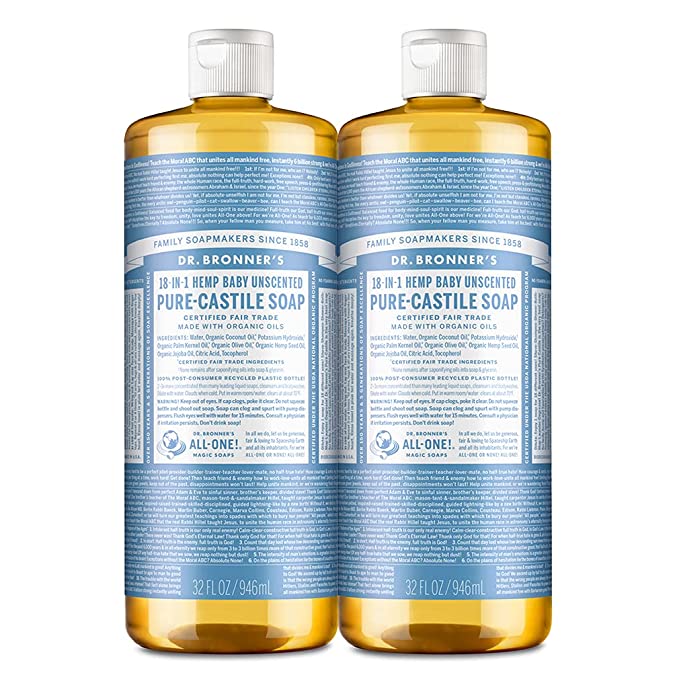
Apply Beneficial Nematodes
Another way to get rid of grapevine larvae is beneficial nematodes. These microscopic organisms live in the soil and infect the newly emerged nymphs. The practical nematode applications should be carried out in spring and early fall when the larvae are close to the ground.
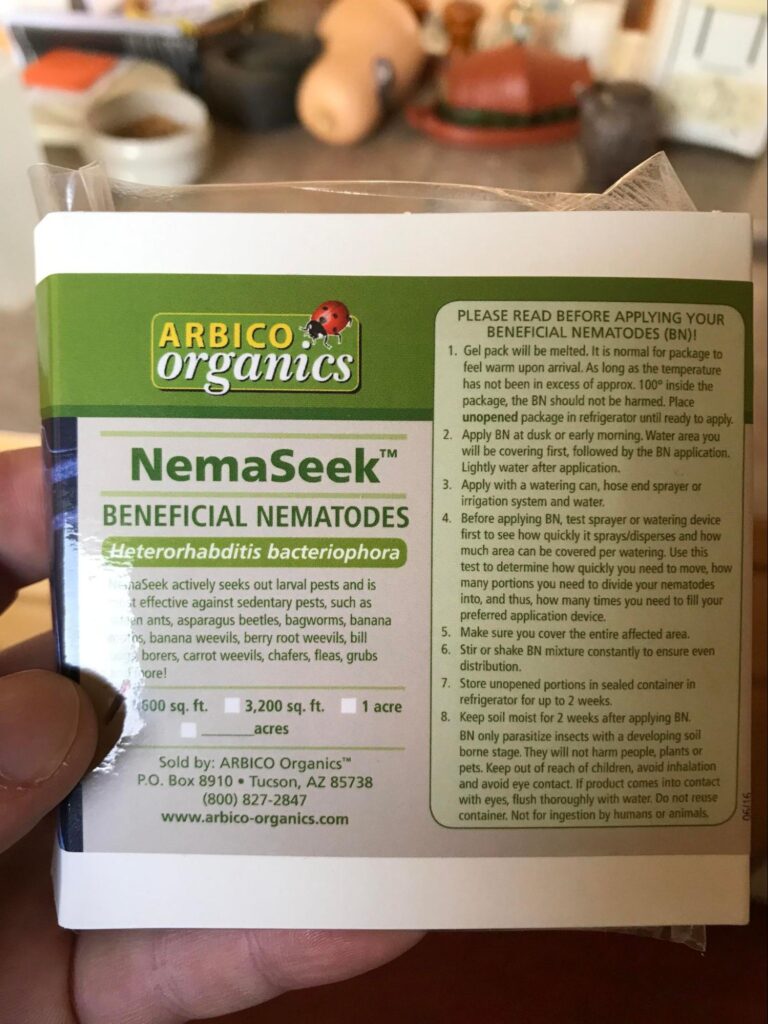
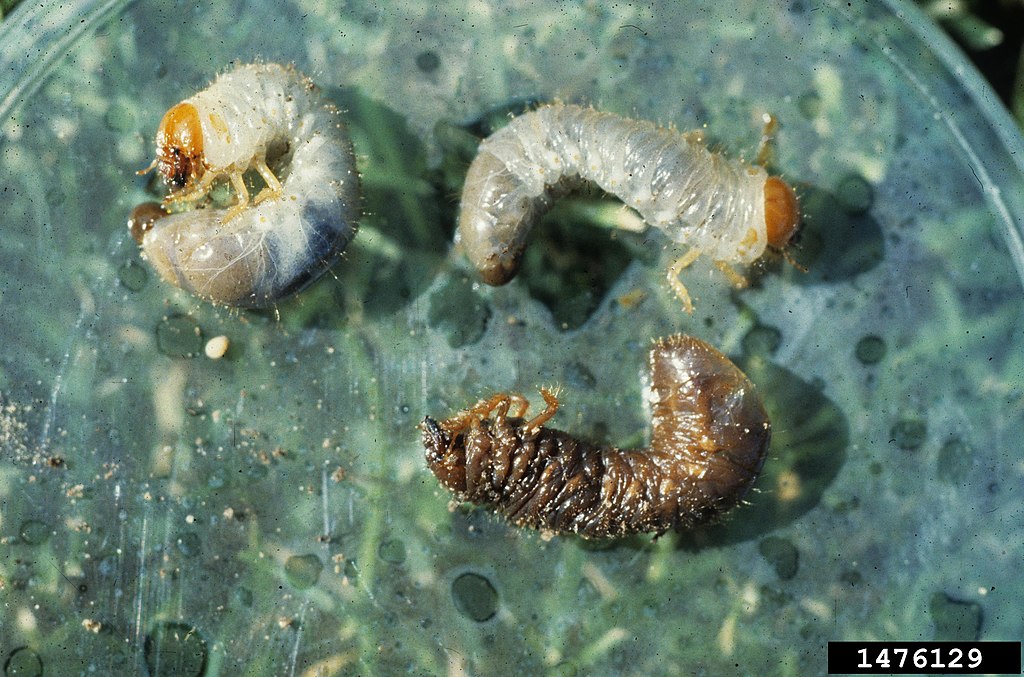
Use Sticky Traps To Control Adult Grapevine Beetles
To manage the adult scarab beetles, use sticky traps. These traps prevent the infestations of adults and thus, interrupt the reproduction cycle. So the deployment of yellow traps in vineyards will interfere with the life cycle of beetles and prevent foliage damage.
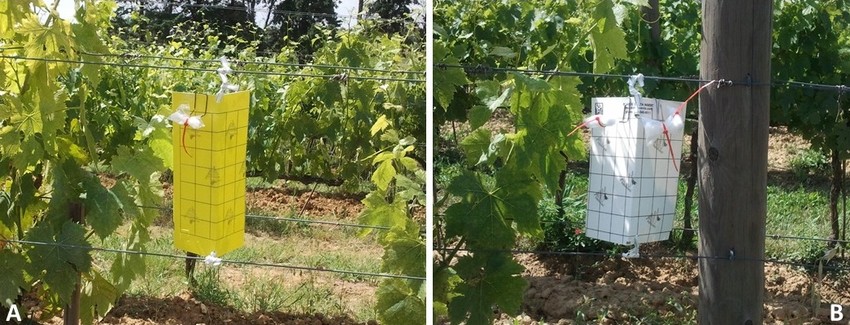
Cultural Practices To Control Scarab Beetle Family
The cultural practices serve the goal of eco-friendly control of grapevine beetles. These practices involve the removal of damaged and weak leaves to discourage the adults and larvae. Try to maintain healthy conditions in vineyards to repel the beatles. And apply weedicides to kill alternate hosts for grapevine beetles.
Permanently remove and properly discard the rotten woods and leaves from outdoors because these beetles prefer decaying, rotting wood for egg-laying. So, they will go somewhere else when the desired rotten lumber is not around the grapevines.
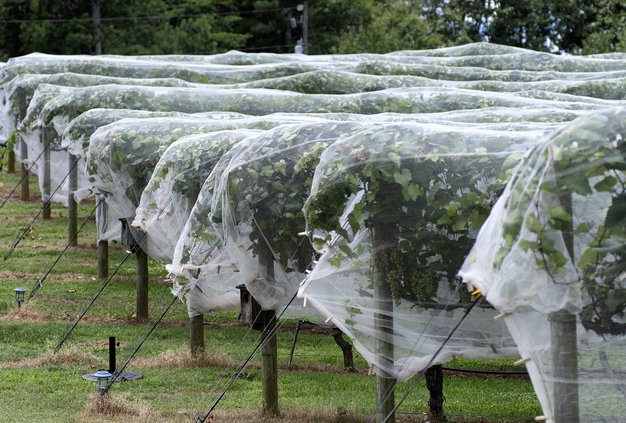
Cover grapevines with mesh clothes during the beetle season (late summer and early fall) to prevent beetle infestation and other pests and birds from attacking. It will also protect vines from sunburn.
RELATED: Black Beetles 101: Types and A Comprehensive Identification Guide with Pictures
Use Milky Sprays To Control Grapevine Beetles
The application of milky spores also effectively controls the grapevine beetle grubs and adults. These spores are of bacterial origin and kill the grubs when they eat them. These spores are also harmless to other beneficial insects.
The one drawback of milky spores is it takes years to be active. However, once these milky spores are active, they last for many years.
Frequently Asked Questions (FAQs)
Are spotted Grapevine Beetles Harmful?
Spotted grapevine beetles are not harmful to humans, pets, and plants. They rarely cause any damage to plants and other animals. However, they only have an appetite for foliage. During feeding on leaves, they make holes in them. Also, they are not considered a significant pest for vineyards.
Where Do Grapevine Beetles Live?
Grapevine beetles live in rotting wood, thickets, forests, and are primarily found in the eastern part of Canada, southern and central united states.
What Beetles Eat Grape Leaves?
The member of the genus pelidnota eats grapevine foliage. They skeletonize the leaves and make holes in them. At the same time, the grubs of these beetles feed on vine roots after hatching from eggs.
What Are the Most Important Insect Pests that Affect Grapevines?
Following are the worst enemies of grapevines:
- Mealybugs
- Mites
- Leaf eating caterpillars
- Grape leaf folder
- Thrips
- Grape cane girdler
- Flea beetle
- Grape root borer
- Grape berry moth
- Grape cane gall maker
Sources For Further Reading
- Heller, P. (2017, March 9). Green June Beetle. PennState Extension. Retrieved January 24, 2022, from https://extension.psu.edu/green-june-beetle
- Smith, Z. (2021, February 1). How to Get Rid of Beetles in Your Home & Yard [2021 Guide]. Smith’s Pest Management. Retrieved January 24, 2022, from https://smithspestmanagement.com/blog/post/how-to-get-rid-of-beetles-in-your-home-yard/
- Beaulieu, D. (n.d.). How to Get Rid of June Bugs. The Spruce. Retrieved January 24, 2022, from https://www.thespruce.com/how-to-get-rid-of-june-bugs-4688779#:~:text=The%20most%20effective%20chemical%20remedy,be%20killed%20by%20the%20insecticide.
Learn more about other plant bugs, read these:
Springtails on Houseplants & Effective Ways to Get Rid of Them?







